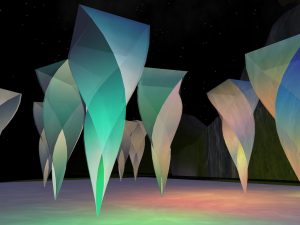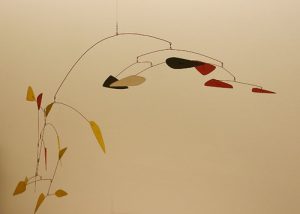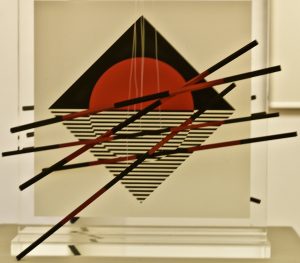The name derives from the Greek word “Kinesis”, meaning movement. Kinetic art focuses on forms which contain and express motion. It was revolutionary because it created a new concept of dimension.

Image source:
https://search.creativecommons.org/photos/132482ea-6e05-41e0-8928-d074a81e3dd3
by Michael Prados
History of The Movement
Kineticism is an art movement that developed mostly in Europe and USA between 1920 and 1970. The movement was not recognised as one until 1955 when the exhibition Le Mouvement took place at Galerie Denise Renè in Paris. Kinetic artists referred to real and apparent motion in their works. Marcel Duchamp, Vladimir Tatlin, and László Moholy-Nagy are considered early Kinetic artists for their interpretation of abstractions of time and space that destabilized formal structures through mechanized motion.
The achievement of international success also corresponds to the beginning of the descending parable of kinetic art caused by the debut of new movements like Pop Art that reduced its visibility.
During the 2000s Kinetic art was the subject of rediscovery by critics. In Italy, the Gnam of Rome organized the exhibition “Programmed and kinetic art” in 2012. In the same year, the New Museum of Contemporary Art in New York organized the exhibition “Ghosts in the machine”, followed in 2013 by the exhibition “Perception and Illusion: Programmed and Italian Kinetic Art” at the Museo de Arte Contemporáneo in Buenos Aires.

Image source: https://search.creativecommons.org/photos/8075d3b4-db8b-4d9f-929f-48f5e963cfce by Lance Shields
Kinetic art
The movement focuses on the perception of dynamism on canvas, the optic phenomena and the perception of light into the human mind. Breaking the rules of traditional art, which sees the artwork as expressions, Kinetic art aims to involve the observer not only in a formal and emotional way: the participation is needed on psychological and perspective levels as well. Among its forerunners Dadaism, Futurism, Impressionism, Constructivism and the Bauhaus. Dynamism and its representation are crucial in Kinetic Art; the movement is viewed as the opposite of immobility and alienation, the great social illness. Expanded during the Twenties, this artistic movement had its full development in the decade between 1950-1960, years during which studies on psychology, personality and perception became increasingly important.
In Italy, Programmatic art developed in parallel to Kinetic art thanks to Bruno Munari and others.

Image source:https://search.creativecommons.org/photos/9eb3df97-8330-4119-aa64-489923a39b61 by judy dean
Characteristics
The kinetic art movement was the first to offer motion effect representation, in paintings and sculptures, which extended in time and space. This was revolutionary because it introduced an entirely new dimension into the viewing experience.
Different artists expressed a diverse attitude on this process: however those more influenced by Constructivism felt that by embracing the machine, art could integrate itself with everyday life, taking on a new central role in the Utopian societies of the future; artists more influenced by Dada applied mechanical processes in a satirical spirit, to comment on the potential enslavement of humankind by science, technology, and capitalist production.
Many Kinetic artists were interested in analogies between machines and human bodies.

Image source: https://search.creativecommons.org/photos/ce9c9df0-13c6-4a8c-81fa-9dbecc5ecd60.
by Cea.
Artists
The most influent artists worked around Europe and USA, some forming artistic groups, others worked mostly by themselves.
One of the most famous exponent of this movement is Alexander Calder, an American artist.
In Italy:
– Bruno Munari, founder of the Programmatic art
– Enzo Mari
– the T Group (founded in Milan by D. Boriani, G. Colombo, G. De Vecchi, G. Varisco);
– the N Group (founded in Padua in 1959 by A. Biasi, E. Chiggio, T. Costa, E. Landi, M. Massironi);
In France:
– Jesús-Rafael Soto
– the GRAV (Groupe de Recherche d’Art Visuel, founded in Paris in 1960 by H. Garcia-Rossi, J. Le Parc, F. Morellet, F. Sombrino, J. Stein, Yvaral);
In Russia:
– the Dviženie group (“movement”, founded in Moscow in 1962 by L. Nusberg, A. Krivtchikov, F. Infante, A. Stepanov).

Image source:https://search.creativecommons.org/photos/b10cba90-1a58-4b16-aa72-eb7f676b0cb4 by pedrosimoes7
Info source:
https://m.theartstory.org/movement/kinetic-art/artworks/
https://www.guggenheim.org/artwork/movement/kinetic-art
https://www.moma.org/collection/terms/170
https://www.treccani.it/enciclopedia/arte-cinetica/
